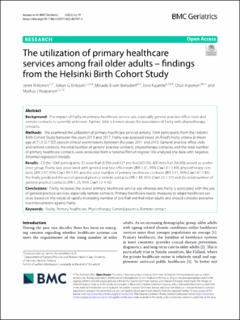| dc.contributor.author | Ikonen, Jenni N | |
| dc.contributor.author | Eriksson, Johan G | |
| dc.contributor.author | von Bonsdorff, Mikaela B | |
| dc.contributor.author | Kajantie, Eero Olavi | |
| dc.contributor.author | Arponen, Otso | |
| dc.contributor.author | Haapanen, Markus J | |
| dc.date.accessioned | 2023-01-31T15:48:06Z | |
| dc.date.available | 2023-01-31T15:48:06Z | |
| dc.date.created | 2022-04-25T10:25:35Z | |
| dc.date.issued | 2022 | |
| dc.identifier.citation | BMC Geriatrics. 2022, 22 (1), . | en_US |
| dc.identifier.issn | 1471-2318 | |
| dc.identifier.uri | https://hdl.handle.net/11250/3047504 | |
| dc.description.abstract | Background
The impact of frailty on primary healthcare service use, especially general practice office visits and remote contacts, is currently unknown. Further, little is known about the association of frailty with physiotherapy contacts.
Methods
We examined the utilization of primary healthcare services among 1064 participants from the Helsinki Birth Cohort Study between the years 2013 and 2017. Frailty was assessed based on Fried’s frailty criteria at mean age of 71.0 (2.7 SD) years in clinical examinations between the years 2011 and 2013. General practice office visits and remote contacts, the total number of general practice contacts, physiotherapy contacts, and the total number of primary healthcare contacts were extracted from a national Finnish register. We analyzed the data with negative binomial regression models.
Results
Of the 1064 participants, 37 were frail (3.5%) and 427 pre-frail (40.1%); 600 non-frail (56.4%) served as a reference group. Frailty was associated with general practice office visits (IRR 1.31, 95% CI=1.01-1.69), physiotherapy contacts (IRR 2.97, 95% CI=1.49-5.91) and the total number of primary healthcare contacts (IRR 1.41, 95% CI=1.07-1.85). Pre-frailty predicted the use of general practice remote contacts (IRR 1.39, 95% CI=1.22-1.57) and the total number of general practice contacts (IRR 1.25, 95% CI=1.12-1.40).
Conclusions
Frailty increases the overall primary healthcare service use whereas pre-frailty is associated with the use of general practice services, especially remote contacts. Primary healthcare needs measures to adapt healthcare services based on the needs of rapidly increasing number of pre-frail and frail older adults and should consider preventative interventions against frailty. | en_US |
| dc.language.iso | eng | en_US |
| dc.publisher | BMC | en_US |
| dc.rights | Navngivelse 4.0 Internasjonal | * |
| dc.rights.uri | http://creativecommons.org/licenses/by/4.0/deed.no | * |
| dc.title | The utilization of primary healthcare services among frail older adults – findings from the Helsinki Birth Cohort Study | en_US |
| dc.title.alternative | The utilization of primary healthcare services among frail older adults – findings from the Helsinki Birth Cohort Study | en_US |
| dc.type | Peer reviewed | en_US |
| dc.type | Journal article | en_US |
| dc.description.version | publishedVersion | en_US |
| dc.source.pagenumber | 0 | en_US |
| dc.source.volume | 22 | en_US |
| dc.source.journal | BMC Geriatrics | en_US |
| dc.source.issue | 1 | en_US |
| dc.identifier.doi | 10.1186/s12877-022-02767-4 | |
| dc.identifier.cristin | 2018818 | |
| cristin.ispublished | true | |
| cristin.fulltext | original | |
| cristin.qualitycode | 1 | |

